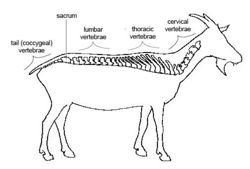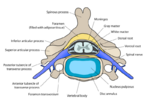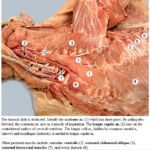Difference between revisions of "Spinal Column - Anatomy & Physiology"
Jump to navigation
Jump to search
Fiorecastro (talk | contribs) |
|||
| (24 intermediate revisions by 9 users not shown) | |||
| Line 1: | Line 1: | ||
| − | + | <big><center>[[Musculoskeletal System - Anatomy & Physiology|'''BACK TO MUSCULOSKELETAL ANATOMY AND PHYSIOLOGY''']]</center></big> | |
| − | |||
[[Image:Anatomy_and_physiology_of_animals_Regions_of_a_vertebral_column.jpg|thumb|right|250px|Divisions of the spinal cord- Copyright Ruth Lawson Otago Polytechnic ]] | [[Image:Anatomy_and_physiology_of_animals_Regions_of_a_vertebral_column.jpg|thumb|right|250px|Divisions of the spinal cord- Copyright Ruth Lawson Otago Polytechnic ]] | ||
| − | |||
| − | |||
| − | The common pattern of canine landmarks, according to Dyce, Sack, et al, can be | + | =''Divisions and Landmarks''= |
| + | The common pattern of canine landmarks, according to Dyce, Sack, et al, can be quantified as such: | ||
[[Image:Spinal landmarks.jpg|center|500px|Spinal Landmarks - Copyright Becky Pocock 2008]] | [[Image:Spinal landmarks.jpg|center|500px|Spinal Landmarks - Copyright Becky Pocock 2008]] | ||
| − | = | + | =''Vertebrae and Joints''= |
| + | [[Image:Cervical Vertebra.png|thumb|right|150px|Cervical Vertebra - Wikimedia Commons 2008]] | ||
| + | *Vertebrae consist of a body which encloses the vertebral foramen (through which the spinal cord and meninges run), a spinous process, and a transverse process, as well as articular processes by which they join together | ||
| + | *The form of the spinous process varies with respect to species and region | ||
| − | |||
| − | |||
| − | |||
| − | |||
| − | |||
| − | |||
| − | == | + | ==Cervical Vertebrae== |
| + | *The first two cervical vertebrae are known as the '''atlas''' and the '''axis''' respectively, and are modified to allow movement of the head | ||
| + | **The atlas has no conventional body: instead it is complsed of two lateral masses joined by dorsal and ventral arches | ||
| + | **The atlas and axis are fused in embryonic life | ||
| + | **The '''wing of the atlas''' is the transverse process of this vertebra and allows the spinal column to articulate with the skull by providing a resting place for the occipital condyles | ||
| + | **The axis is the longest vertebra | ||
| + | **The '''nuchal ligament''' connects the spinous process of the axis to the spinous process of the first thoracic vertebra (T1) | ||
| + | *The last (C7) cervical vertebra has a taller spinous process than those proceeding it, and articulates with the first pair of ribs | ||
| − | + | ==Thoracic Vertebrae== | |
| + | *Thoracic vertebrae articulate with the ribs | ||
| + | *They are distingushed by short bodies with flattened extremities, costal facets, short transverse processes, and prominent spinous processes | ||
| + | *They reach a maximum height a few vertebrae behind the cervicothoracic junction (constituting the '''withers''' of the horse) and then decline | ||
| + | *The orientation of spinous processes shifts from caudo- to craniodorsal | ||
| − | == | + | ==Lumbar Vertebrae== |
| + | *Longer and more uniform in shape than thoracic vertebrae | ||
| + | *Shorter in height, with long, flattened transverse processes that project laterally | ||
| − | + | ==Sacral Vertebrae== | |
| + | *'''Sacrum''': a single bone formed by the fusion of several vertebrae that articulates with the pelvic girdle | ||
| + | *Allows the thrust of the hindlimbs to be transmitted to the trunk | ||
| + | *Narrows caudally and is curved to present a concave surface to the pelvic cavity | ||
| − | + | ==Caudal Vertebrae== | |
| − | + | *Number varies greatly even within species | |
| − | + | *Progressive simplification of form | |
==Joints of the Spinal Column== | ==Joints of the Spinal Column== | ||
| + | *Two types of joints: | ||
| + | **Cartilaginous: direct connections between vertebral bodies | ||
| + | ***Bodies of adjacent vertebrae connected by thick, flexible intervertebral discs, consisting of two parts: | ||
| + | ****'''Nucleus pulposus''': slightly eccentric, notochord derivative, contained under pressure and prone to escape | ||
| + | ****'''Annulus fibrosis''': encircling bundles of fibrous tissue that pass obliquely from one vertebra to another, with changing orientation | ||
| + | **Synovial: between facets on vertebral arches | ||
| + | *Modified in the regions of the head and pelvis | ||
| + | **Joints of the atlas: | ||
| + | ***'''Atlanto-occipital joint''': between condyles of the skull and corresponding cavities of the atlas | ||
| + | ****Functions as a ginglymus: movement is restricted to flexion/extension in the sagittal plane (eg nodding) | ||
| + | ***'''Atlantoaxial joint''': ventral arch of atlas and the body of the axis face into a single synovial cavity with limited areas of contact | ||
| + | ****Movement is rotational about a longitudinal axis (eg. head shaking) | ||
| − | + | =''Spinal Cord''= | |
| − | |||
| − | |||
| − | |||
| − | |||
| − | |||
| − | |||
| − | |||
| − | |||
| − | |||
| − | |||
| − | |||
| − | |||
| − | |||
| − | |||
| − | |||
| − | |||
| − | |||
| − | |||
| − | |||
| − | |||
| − | |||
| − | |||
| − | |||
| − | |||
| − | |||
| − | |||
| − | |||
| − | |||
| − | |||
| − | |||
| − | |||
| − | |||
| − | |||
| − | |||
| − | |||
| − | |||
| − | |||
| − | |||
| − | = | ||
| − | |||
| − | |||
| − | |||
| − | |||
| − | |||
| − | |||
| − | |||
| − | |||
| − | '''Longus capitis''' | + | =''Hypaxial and Epaxial Muscles''= |
| − | : | + | [[Image: epaxial muscles.JPG|thumb|right|150px|Epaxial muscles- Copyright C. Clarkson and T.F. Fletcher, University of Minnesota]] |
| + | *'''Epaxial muscles''': extensors of the vertebral column | ||
| + | **Dorsal to the line of the transverse processes of the vertebrae | ||
| + | **Innervation comes from the dorsal branches of the spinal nerves | ||
| + | **Rarely of clinical importance | ||
| + | **Arranged in three parallel columns | ||
| + | ***Lateral column: ''Iliocostalis'' arises from the ilium and transverse processes of the lumbar vertebrae to insert on cranial lumbar vertebrae and ribs, spanning about 4 vertebrae | ||
| + | ***Middle column: ''Longissimus''; strongest, extending from the ilium and sacrum to the head and neck | ||
| + | ***Medial column: ''Transversospinalis''; most complex, lying between medial vertebral arches and spinous processes | ||
| + | [[Image: hypaxial muscles.JPG|thumb|right|150px|Hypaxial muscles- Copyright C. Clarkson and T.F. Fletcher, University of Minnesota]] | ||
| + | *'''Hypaxial Muscles''': flexors of the neck and tail | ||
| + | **''Longus colli'': from cranial thoracic region to the atlas, covering ventral vertebral bodies | ||
| + | **''Rectus capitis ventralis'': atlas to ventral skull | ||
| + | **''Longus capitis'': midcervical vertebrae to skull | ||
| + | **''Scalenus'' muscles: caudal cervica vertebrae to first few ribs, which they stabilize on inspiration | ||
| − | |||
| − | |||
| − | |||
| − | |||
| − | |||
| − | |||
| − | |||
| − | + | <big><center>[[Musculoskeletal System - Anatomy & Physiology|'''BACK TO MUSCULOSKELETAL ANATOMY AND PHYSIOLOGY''']]</center></big> | |
| − | < | ||
| − | [[ | ||
| − | |||
Revision as of 15:43, 13 August 2008
Divisions and Landmarks
The common pattern of canine landmarks, according to Dyce, Sack, et al, can be quantified as such:
Vertebrae and Joints
- Vertebrae consist of a body which encloses the vertebral foramen (through which the spinal cord and meninges run), a spinous process, and a transverse process, as well as articular processes by which they join together
- The form of the spinous process varies with respect to species and region
Cervical Vertebrae
- The first two cervical vertebrae are known as the atlas and the axis respectively, and are modified to allow movement of the head
- The atlas has no conventional body: instead it is complsed of two lateral masses joined by dorsal and ventral arches
- The atlas and axis are fused in embryonic life
- The wing of the atlas is the transverse process of this vertebra and allows the spinal column to articulate with the skull by providing a resting place for the occipital condyles
- The axis is the longest vertebra
- The nuchal ligament connects the spinous process of the axis to the spinous process of the first thoracic vertebra (T1)
- The last (C7) cervical vertebra has a taller spinous process than those proceeding it, and articulates with the first pair of ribs
Thoracic Vertebrae
- Thoracic vertebrae articulate with the ribs
- They are distingushed by short bodies with flattened extremities, costal facets, short transverse processes, and prominent spinous processes
- They reach a maximum height a few vertebrae behind the cervicothoracic junction (constituting the withers of the horse) and then decline
- The orientation of spinous processes shifts from caudo- to craniodorsal
Lumbar Vertebrae
- Longer and more uniform in shape than thoracic vertebrae
- Shorter in height, with long, flattened transverse processes that project laterally
Sacral Vertebrae
- Sacrum: a single bone formed by the fusion of several vertebrae that articulates with the pelvic girdle
- Allows the thrust of the hindlimbs to be transmitted to the trunk
- Narrows caudally and is curved to present a concave surface to the pelvic cavity
Caudal Vertebrae
- Number varies greatly even within species
- Progressive simplification of form
Joints of the Spinal Column
- Two types of joints:
- Cartilaginous: direct connections between vertebral bodies
- Bodies of adjacent vertebrae connected by thick, flexible intervertebral discs, consisting of two parts:
- Nucleus pulposus: slightly eccentric, notochord derivative, contained under pressure and prone to escape
- Annulus fibrosis: encircling bundles of fibrous tissue that pass obliquely from one vertebra to another, with changing orientation
- Bodies of adjacent vertebrae connected by thick, flexible intervertebral discs, consisting of two parts:
- Synovial: between facets on vertebral arches
- Cartilaginous: direct connections between vertebral bodies
- Modified in the regions of the head and pelvis
- Joints of the atlas:
- Atlanto-occipital joint: between condyles of the skull and corresponding cavities of the atlas
- Functions as a ginglymus: movement is restricted to flexion/extension in the sagittal plane (eg nodding)
- Atlantoaxial joint: ventral arch of atlas and the body of the axis face into a single synovial cavity with limited areas of contact
- Movement is rotational about a longitudinal axis (eg. head shaking)
- Atlanto-occipital joint: between condyles of the skull and corresponding cavities of the atlas
- Joints of the atlas:
Spinal Cord
Hypaxial and Epaxial Muscles
- Epaxial muscles: extensors of the vertebral column
- Dorsal to the line of the transverse processes of the vertebrae
- Innervation comes from the dorsal branches of the spinal nerves
- Rarely of clinical importance
- Arranged in three parallel columns
- Lateral column: Iliocostalis arises from the ilium and transverse processes of the lumbar vertebrae to insert on cranial lumbar vertebrae and ribs, spanning about 4 vertebrae
- Middle column: Longissimus; strongest, extending from the ilium and sacrum to the head and neck
- Medial column: Transversospinalis; most complex, lying between medial vertebral arches and spinous processes
- Hypaxial Muscles: flexors of the neck and tail
- Longus colli: from cranial thoracic region to the atlas, covering ventral vertebral bodies
- Rectus capitis ventralis: atlas to ventral skull
- Longus capitis: midcervical vertebrae to skull
- Scalenus muscles: caudal cervica vertebrae to first few ribs, which they stabilize on inspiration




